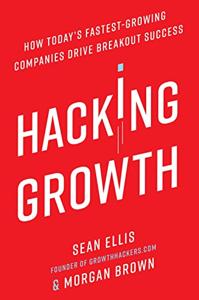
Want to learn the ideas in Hacking Growth better than ever? Read the world’s #1 book summary of Hacking Growth by Sean Ellis, Morgan Brown here.
Read a brief 1-Page Summary or watch video summaries curated by our expert team. Note: this book guide is not affiliated with or endorsed by the publisher or author, and we always encourage you to purchase and read the full book.
Video Summaries of Hacking Growth
We’ve scoured the Internet for the very best videos on Hacking Growth, from high-quality videos summaries to interviews or commentary by Sean Ellis, Morgan Brown.
1-Page Summary of Hacking Growth
Overview
Any business owner will tell you that growing a small company into a big one is tough. However, it’s easier now since there are so many new possibilities in online marketplaces.
Online business provides a lot of new opportunities, but it also presents a host of new problems. It allows us to test our products and learn from customers better than ever before. These two things are key factors in hacking growth.
Here are the key points that explain growth hacking. These points provide a systematic way to collect, analyze and test data from your business. You’ll also find out how a college football team can teach you about efficient business practices; how data about your customer’s internet connection is important; and how to find your company’s North Star.
Big Idea #1: Growth teams use inter-department collaboration and strong leadership to get results.
A common scenario for entrepreneurs is that they’re making a profit, but need to find ways to make it bigger.
The author suggests that you prioritize growth by creating a growth team. A growth team is made up of people from different departments within your company and it focuses on finding ways to grow.
Let’s look at a real-world example. BitTorrent was doing fine until 2012, when it plateaued and needed to grow again.
One of the company’s products was being used by too many customers, which caused problems. The company tried to fix those problems by improving the paid version but few people upgraded.
However, things changed when a new project-marketing manager came on board. He created a growth team and brought fresh perspective to the organization. It became clear that customers weren’t upgrading because they didn’t know what was available in the premium version or how it would benefit them.
A team of engineers and marketers came together to come up with a solution. They promoted the premium version to users of the free one, which led to an increase in revenue by 92%. However, for this team’s success, it needs a strong leader who can unite them and keep them on track toward their goal. The leader will identify the target area (i.e., developing new marketing channels), set clear goals (i.e., three potential new ones by the end of the month) and establish time frames for accomplishing these goals (by that date).
The growth leader is responsible for helping the team move forward and staying focused. An attractive idea that doesn’t serve the current goal can be distracting, so it’s important to recognize these ideas when they come up and put them on hold.
Big Idea #2: To develop a must-have product, you need to know your customers well.
There are many entrepreneurs who want to start the next Airbnb, Yelp, Facebook or Amazon. Each of these companies experienced rapid growth because they all have something in common: a must-have product or service that people love.
Even if you’re sure people love your product, it’s important to find out how they feel about it. The best way to do that is by asking customers a simple question: Is this product a must-have? By surveying at least 300 of your customers, you’ll be able to figure out how they feel about the product.
Here’s a question: “How disappointed would you be if this product no longer existed tomorrow?” And here are the three possible answers: A. Very disappointed B. Somewhat disappointed C. Not disappointed If at least 40% of your customers answer, “Very Disappointed,” then you can start to use growth hacking techniques that are described in the key points ahead. However, if less than 40% of your customers say they’d be very disappointed without this product, you must continue to improve and develop it until more people think it’s a necessity rather than just something nice-to-have.





